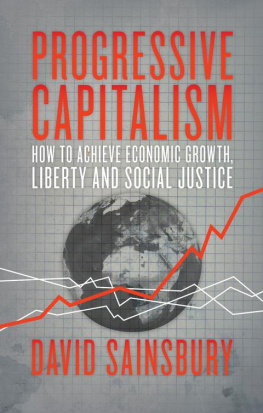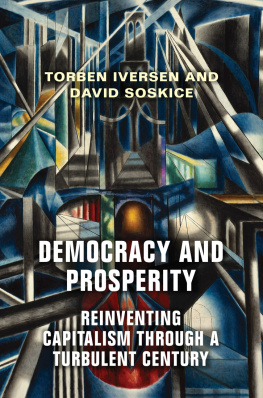THE POWER OF CREATIVE DESTRUCTION
Economic Upheaval and the Wealth of Nations
PHILIPPE AGHION CLINE ANTONIN SIMON BUNEL
Translated by Jodie Cohen-Tanugi
The Belknap Press of Harvard University Press
CAMBRIDGE, MASSACHUSETTS LONDON, ENGLAND 2021
Copyright 2021 by the President and Fellows of Harvard College
All rights reserved
First published as Le Pouvoir de la destruction cratrice, copyright 2020 Odile Jacob
Cover design: Marina Drukman
978-0-674-97116-5 (cloth)
978-0-674-25866-2 (EPUB)
978-0-674-25868-6 (PDF)
The Library of Congress has cataloged the printed edition as follows:
Names: Aghion, Philippe, author. | Antonin, Cline, author. | Bunel, Simon, author.
Title: The power of creative destruction : economic upheaval and the wealth of nations / Philippe Aghion, Cline Antonin, Simon Bunel; translated by Jodie Cohen-Tanugi.
Description: Cambridge, Massachusetts : The Belknap Press of Harvard University Press, 2021. | First published as Le Pouvoir de la destruction cratrice, copyright 2020 Odile JacobTitle page verso. | Includes bibliographical references and index.
Identifiers: LCCN 2020048914
Subjects: LCSH: Capitalism. | Disruptive technologies. | Business cycles. | Income distribution.
Classification: LCC HB501 .A459 2021 | DDC 330.12/2dc23
LC record available at https://lccn.loc.gov/2020048914
Contents
We began writing this book in November of 2019. Four months later an unprecedented, worldwide pandemic crisis struck. This crisis stimulated existential debate on how our society will lookand how we want to reshape itwhen we emerge from the crisis. At the heart of the debate we find creative destruction. Indeed, COVID-19 has destroyed jobs and pushed huge numbers of firms into bankruptcy. Yet at the same time, the crisis has created room for new, innovative activities.
As Barry Eichengreen explained in a recent article in Prospect (May 26, 2020) with the evocative title, Schumpeters Virus: How Creative Destruction Could Save the Coronavirus Economy, the retail sector will utilize artificial intelligence and automation more than ever, because consumers will not give up the habit of ordering online that they acquired during social confinement. Similarly, confinement revealed the virtues of remote working and of videoconferences. We also became acquainted with medical consultations by telephone or video.
However, the realization that creative destruction can serve as a lever of growth after COVID presents a challenge to policy makers. On the one hand, they must protect: support viable firms in order to save jobs and preserve the human capital accumulated in those firms. On the other hand, they must reallocate: encourage the entry of new firms and new activities that are more efficient or more responsive to the new needs of consumers. In other words, they must accompany the process of creative destruction, without obstructing it.
More importantly, the COVID-19 crisis acted as a wake-up call by revealing deeper problems that plague capitalism in the different forms it takes throughout the world: dysfunctional social welfare and health-care systems in the United States; inadequate innovation systems in Europe; and the lack of transparency or the excessive centralization of power in yet other countries.
More generally, in light of the rise of inequality, the concentration of rents, increasing job insecurity, and the deterioration of health and the environment that we have observed for decades, we hear more and more calls for radical change, even the overthrow of capitalism. However, in this book we argue that the answer to our problems is not to abolish capitalism. It is to invent a better capitalism by harnessing the power of creative destructioninnovation that disrupts, but that over the past two hundred years has also lifted societies to previously unimagined prosperity.
The challenge we face is therefore to understand the underpinnings of creative destruction in order to steer its power in the direction we choose. How can we direct creative destruction toward greener and more equitable growth? How can we prevent yesterdays innovators from using their rents to block new innovation? How can we minimize the potentially negative effects of creative destruction on employment, health, and happiness? What are the forcesfirms, governments, constitutions, civil societythat enable us to steer creative destruction in the direction we desire? These are the questions we will attempt to answer in the following chapters.
The raw material of this book comes from five years of lectures at the Collge de France, which themselves encompass more than thirty years of research on the economics of innovation and growth. This material was enriched and reorganized around a central theme: the power of creative destruction and how the transformation of capitalism can direct this power toward achieving more sustainable and inclusive prosperity.
___________________
This book is an invitation to a journey: a journey through economic history, more specifically a journey to explore the enigmas of economic growth through the lens of creative destruction.
Creative destruction is the process by which new innovations continually emerge and render existing technologies obsolete, new firms continually arrive to compete with existing firms, and new jobs and activities arise and replace existing jobs and activities. Creative destruction is the driving force of capitalism, ensuring its perpetual renewal and reproduction, but at the same time generating risks and upheaval that must be managed and regulated.
Our purpose in this book is to:
- Penetrate some of the great historical enigmas associated with the process of world growth, such as industrial takeoff, major technological waves, secular stagnation, the evolution of inequality, convergence and divergence across countries, the middle-income trap, and structural change.
- Revisit the great debates over innovation and growth in developed nations: Can we foster innovation and creative destruction while at the same time protecting the environment and reducing inequality? Can we avoid creative destructions potentially detrimental effects on employment, health, and well-being? Must we fear the digital and artificial intelligence revolutions?
- Rethink the role of the state and civil society: What role can each of them play to stimulate innovation and creative destruction and thereby increase the wealth of nations? How can we protect citizens and the economy from the excesses of capitalism?
Even as he extolled the merits of creative destruction as the driving force of growth, Joseph Schumpeter was pessimistic about the future of capitalism. In particular, he anticipated that large conglomerates would push out small and medium-sized firms, leading inexorably to the disappearance of entrepreneurs and the triumph of bureaucracy and vested interests.
1. Measuring the Wealth of Nations
The preferred measure of the wealth of nations is per capita gross domestic product (per capita GDP). Why should we focus on this dry statistic rather than on more literal measures, such as indexes of well-being, consumption, or happiness? One argument is that the material well-being of billions of human beings is closely linked to per capita GDP of the country where they live. For example, the industrial takeoff at the beginning of the nineteenth century corresponded to a takeoff of per capita GDP after a long period of stagnation (see ).









